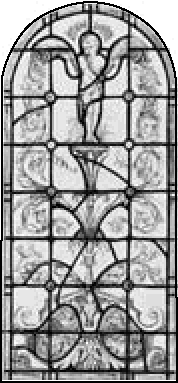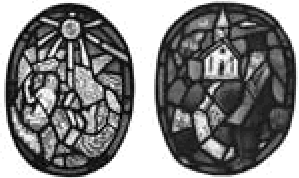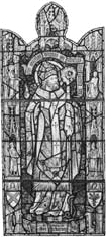Stained Glass from the Studio of Charles J.
Connick in the Collection of the
Museum of Fine Arts, Boston
Although the Charles J. Connick Studio was located in Boston,
The Museum of Fine Arts in that city holds only three examples of its stained
glass in its permanent collection. Furthermore, all three diverge dramatically
from Connick’s usual religious subject matter executed in a Reform Gothic
style.
 One
of the windows at the Museum of Fine Arts was commissioned in 1924 by Paris-educated
sculptor and Museum School professor Frederick Warren Allen (1888-1961)
for his studio at 27 Tavern Road (MFA #1991.449; H: 44 7/8”, W: 20 3/4”).
Allen had agreed to make a bust of Charles Connick in trade for this stained
glass window for his “Italian studio.” (1) A memorandum pertaining to the
Allen window, found in the object file at the museum, bears the notation:
“Make interesting sort of Italian thing.” Made of leaded stained glass,
the window is executed in an Italian Renaissance revival style in which
Allen and other Boston sculptors, including Richard Recchia and Bela Lyon
Pratt, were working at the time.(2) The colors in the glass, predominately
red, blue, yellow, and flesh tones, are also typical of the Renaissance.
Mr. Connick and Professor Allen must have derived as much pleasure from
designing the window as we do in speculating on the symbolism of the horns
of plenty, held by a putto, which spill out a winged mermaid, Pan and his
pipes, a fish, a butterfly, and a bird. Below, on the plinth on which the
putto stands, are two more birds and a rabbit. In the cartoon for
the window are also shown the mustachioed head of a stern man and a bird
with the head of a woman, both obviously intended to be identified, but
omitted from the finished product. In 1954 Adio di Baccari, Allen’s
favorite student, was able to buy the studio. Happily, di Baccari salvaged
the window before the studio was demolished in 1991 and gave it to the
Museum. One
of the windows at the Museum of Fine Arts was commissioned in 1924 by Paris-educated
sculptor and Museum School professor Frederick Warren Allen (1888-1961)
for his studio at 27 Tavern Road (MFA #1991.449; H: 44 7/8”, W: 20 3/4”).
Allen had agreed to make a bust of Charles Connick in trade for this stained
glass window for his “Italian studio.” (1) A memorandum pertaining to the
Allen window, found in the object file at the museum, bears the notation:
“Make interesting sort of Italian thing.” Made of leaded stained glass,
the window is executed in an Italian Renaissance revival style in which
Allen and other Boston sculptors, including Richard Recchia and Bela Lyon
Pratt, were working at the time.(2) The colors in the glass, predominately
red, blue, yellow, and flesh tones, are also typical of the Renaissance.
Mr. Connick and Professor Allen must have derived as much pleasure from
designing the window as we do in speculating on the symbolism of the horns
of plenty, held by a putto, which spill out a winged mermaid, Pan and his
pipes, a fish, a butterfly, and a bird. Below, on the plinth on which the
putto stands, are two more birds and a rabbit. In the cartoon for
the window are also shown the mustachioed head of a stern man and a bird
with the head of a woman, both obviously intended to be identified, but
omitted from the finished product. In 1954 Adio di Baccari, Allen’s
favorite student, was able to buy the studio. Happily, di Baccari salvaged
the window before the studio was demolished in 1991 and gave it to the
Museum.
The other examples of Connick stained glass are two leaded
oval medallion windows created in 1928 for the library of Gino L. Perera
at 382 Commonwealth Avenue, Boston (MFA #’s 1986.356 and .357; 15” x 11
3/4” and 15” x 12”). These medallions were given to the Museum by the Charles
J. Connick Foundation. At this time it is not known how they had made their
way back to the Studio. Noted as “Job 1323,” the cost was $150 for each
window! The windows are based on a poem titled “Ballad of Old Doc Higgins”
by Leonora Speyer. (3) In this narrative “Old Doc Higgins,” who loves to
fish, shoots “The Mermaid” because her “catterwaulin’ up the river” drove
the fish away “just as they was bitin” and, even worse, “naked to the waist
and sassy!”, she seduced his sister’s young son. In the end, phantom mermaids  drown
Old Doc Higgins “with their arms like wreaths around him, heavy, silver
wreaths around him,/ Struggling, strangling,..../Thus he lies-/In a grave
of running water, who had slain a deep-sea daughter.” One window depicts
a dark suited, top hatted gentleman facing left, one finger to his lips,
standing at the end of a path which leads to a white country church, perhaps
contemplating the dark deed he has just committed. The other shows a mermaid
in the right foreground, mouth open in surprise (at the sight of a gun?),
her scaled tail surrounded by fish and other creatures of the deep. A large
sun shines from the upper left. The clear, bright colors - red, blue, yellow,
green - enhance the primitive and whimsical style. Connick referred to
the subject of these works as a “pedagogue and his vision.” (4) drown
Old Doc Higgins “with their arms like wreaths around him, heavy, silver
wreaths around him,/ Struggling, strangling,..../Thus he lies-/In a grave
of running water, who had slain a deep-sea daughter.” One window depicts
a dark suited, top hatted gentleman facing left, one finger to his lips,
standing at the end of a path which leads to a white country church, perhaps
contemplating the dark deed he has just committed. The other shows a mermaid
in the right foreground, mouth open in surprise (at the sight of a gun?),
her scaled tail surrounded by fish and other creatures of the deep. A large
sun shines from the upper left. The clear, bright colors - red, blue, yellow,
green - enhance the primitive and whimsical style. Connick referred to
the subject of these works as a “pedagogue and his vision.” (4)
While these three examples of Connick’s work in the MFA
may differ from his church windows, they show the same use of pure, “antique”
glass and dynamic color composition which made this studio famous.
(1) Laurel Beetham (Allen’s granddaughter), paper for
Professor Lewis, April 22, 1978, ADA files at MFA.
(2) Each of these three sculptors executed one of the
friezes on the Huntington Avenue facade of the MFA.
(3) Leonora Speyer, Slow Wall, Poems New & Selected,
1939, Alfred A. Knopf, New York: pp. 117-124.
(4) Connick Foundation archives, thanks to Marilyn Justice.
|
 |
Grateful thanks to:
|
Anne Dort Moffett, Department Assistant, American Decorative
Arts and Sculpture, Museum of Fine Arts, for her delightful article printed
above.
Joan Gaul, a free-lance writer who has specialized in
the work of early stained glass makers in Pittsburgh, PA, for her account
of the Glory in Glass exhibit.
Patricia Gibbons, Administrator of the Heinz Memorial
Chapel, for her news of the Connick exhibit at the University of Pittsburgh. |
|
 |
Photographs of cartoons for the
Frederick Allen window and the St. Patrick window, St. Vincent Ferrer from
Connick Archives, Fine Arts Department, courtesy of the
Trustees, Boston Public Library. |
 |
Medallion photographs, “Old Doc
Higgins” and “The Mermaid”, courtesy of the Museum of Fine Arts, Boston |
 |
Please address questions, comments
and/or gifts to The Charles J. Connick Stained Glass Foundation, 37 Walden
Street, Newtonville, MA 02460. |
|
|
|
Connick News
 •
Glory
in Glass: Stained Glass in the United States; Origins, Variety, and Preservation
will be at the Gallery of the American Bible Society, 1865 Broadway, New
York City until February 16, 1999. The exhibition treats the history
and techniques of religious stained glass from medieval times through present-day
preservation. Windows, ranging widely in style and period—cartoons, watercolors,
and tools—tell the story. The catalogue’s multiple authors elaborate.
Charles Connick, a frequent referent in the catalogue, is represented in
the show by a watercolor detail of a chancel window at St. Vincent Ferrer.
Connick Associates is represented by sketches for the clerestory of St.
Patrick’s Cathedral. In total the Connick Studio is represented by 14 watercolor
sketches for windows located in St Patrick’s, St. Vincent Ferrer, New York
Presbyterian Hospital, and Princeton University. •
Glory
in Glass: Stained Glass in the United States; Origins, Variety, and Preservation
will be at the Gallery of the American Bible Society, 1865 Broadway, New
York City until February 16, 1999. The exhibition treats the history
and techniques of religious stained glass from medieval times through present-day
preservation. Windows, ranging widely in style and period—cartoons, watercolors,
and tools—tell the story. The catalogue’s multiple authors elaborate.
Charles Connick, a frequent referent in the catalogue, is represented in
the show by a watercolor detail of a chancel window at St. Vincent Ferrer.
Connick Associates is represented by sketches for the clerestory of St.
Patrick’s Cathedral. In total the Connick Studio is represented by 14 watercolor
sketches for windows located in St Patrick’s, St. Vincent Ferrer, New York
Presbyterian Hospital, and Princeton University.
• Creating a Sense of Place: Devotion Builds a Campus
at the University Art Gallery, September 14, 1998 - December 11, 1998 was
composed of four separated exhibits that focused on the diverse sponsorship
of the public art and architecture at the University’s campus during the
twentieth century. The curators for the exhibit were the students from
the 1998 Museum Studies Seminar at the University of Pittsburgh.
The exhibit commemorating Heinz Memorial Chapel’s sixtieth
anniversary was mainly a photographic survey of building. There were vintage
pictures of the construction 1933-1938, photos showing details of the magnificent
stone and iron work, and many wonderful shots of the Chapel’s magnificent
Connick windows. The highlight of the exhibit was the loan of two
of the original gouaches from the Boston Public Library. The gouaches were
for two aisle windows, which are at eye level. This allowed for close inspection
and comparison of the gouaches with the finished product.
|

